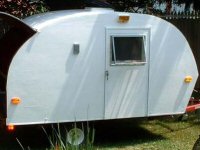Many years ago, deflectors were popular on the cabs of big rigs - highway tractor-trailers. Now, they either have sleepers with high roof aerodynamic designs, or the cab is plain but the trailer has a "bubble" front... few deflectors left to be seen. Hmmm...
Fifth-wheel RV rigs rarely use deflectors, as well, although some older ones still have them. That may be something to do with the configuration when not towing, but I just think it makes more sense to shape the trailer appropriately.
My current trailer is not tiny, and does a good parachute imitation. I have no idea what I will do about that (other than switching to a smaller trailer), but I did notice carrying a big roof box or a canoe (only one of the two fits at a time) might not help drag, but doesn't hurt - maybe surprising, given that it's a huge canoe, longer than the van and quite wide. Perhaps it doesn't matter much whether the roof load or trailer does the air-bashing?
Wind Drag & Turbulance
37 posts
• Page 2 of 3 • 1, 2, 3
More about drag
I design and build experimental aircraft as a hobby. "Experimental" means I fly IN them.
There are different kinds of drag.
INDUCED DRAG: With airplanes, induced drag generally decreases as speed increases. The low-speed, high-drag situation results from having the wings at a high angle of attack to get enough lift to fly at lower airspeeds. If you viewed the airplane from the front at lower airspeeds, you'd see the tail hanging down and a lot of airplane meeting the wind. As the airplane goes faster, the angle of attack of the wings needed to support the weight of the airplane becomes less. Seen from the front, the airplane would look as if you were seeing it sraight-on. This is the lowest induced drag an airplane can get. Even if the airplane goes faster, you can't lessen the induced drag any further.
FORM DRAG: The more streamlined the front of the airplane is, the less form drag it has. More things sticking out on the skin of the airplane add to the form drag -- fixed landing gear, antennas, lights, door handles, etc. Form drag increases as speed increases. This means that any airplane has a top speed in level flight at which total drag equals the total thrust the airplane can produce. To make an airplane go faster, it is easier to refine its streamlining than to add more power.
INTERFERENCE DRAG: This is a component of form drag, basically a kind of drag that results from making vortices, or horizontal whirlpools of air. On a typical wing, for example, the reduced air pressure on top of the wing causes an airflow that migrates outward to the wingtips. The higher air pressure under the wing does the same. When they join, the pressure differences cause the joined air to rotate and separate from the airplane at the wingtip. The result is a drag-causing vortice. (The wingtip vortice at the left wingtip spins in the opposite direction of the one from the right wingtip.) A way to reduce interference drag is to extend the wingtip up or down. This takes some fancy calculating.
FRICTION DRAG or SKIN DRAG: The passage of air over the surface of the aircraft also generates drag. A smooth metal surface generates less skin drag than a metal surface with rivets. The faster sheet-metal airplanes have special rivets that are flush with the surface. With a good coat of paint, they effectively disappear. The fastest airplanes have laminar-flow wings, in which the air follows the shape of the wing exactly because the skin is so smooth. Laminar flow works perfectly as long as the skin is perfectly smooth. A dead bug can mess up laminar flow.
LITTLE DRAG TRICK: Contrary to what you'd think, it is possible to reduce the drag on the rear of the airplane sinply by cutting it off -- instead of reducing its cross-sectional area gradually to a point. If you'd like an example of this, look at the tail fins of the X-15. Again, it takes some calculating.
I'll work up another post to show how this could apply to teardrop trailers. Just remember, I build airplanes as a hobby, and I don't have all the answers. I don't have wind tunnel, either.
There are different kinds of drag.
INDUCED DRAG: With airplanes, induced drag generally decreases as speed increases. The low-speed, high-drag situation results from having the wings at a high angle of attack to get enough lift to fly at lower airspeeds. If you viewed the airplane from the front at lower airspeeds, you'd see the tail hanging down and a lot of airplane meeting the wind. As the airplane goes faster, the angle of attack of the wings needed to support the weight of the airplane becomes less. Seen from the front, the airplane would look as if you were seeing it sraight-on. This is the lowest induced drag an airplane can get. Even if the airplane goes faster, you can't lessen the induced drag any further.
FORM DRAG: The more streamlined the front of the airplane is, the less form drag it has. More things sticking out on the skin of the airplane add to the form drag -- fixed landing gear, antennas, lights, door handles, etc. Form drag increases as speed increases. This means that any airplane has a top speed in level flight at which total drag equals the total thrust the airplane can produce. To make an airplane go faster, it is easier to refine its streamlining than to add more power.
INTERFERENCE DRAG: This is a component of form drag, basically a kind of drag that results from making vortices, or horizontal whirlpools of air. On a typical wing, for example, the reduced air pressure on top of the wing causes an airflow that migrates outward to the wingtips. The higher air pressure under the wing does the same. When they join, the pressure differences cause the joined air to rotate and separate from the airplane at the wingtip. The result is a drag-causing vortice. (The wingtip vortice at the left wingtip spins in the opposite direction of the one from the right wingtip.) A way to reduce interference drag is to extend the wingtip up or down. This takes some fancy calculating.
FRICTION DRAG or SKIN DRAG: The passage of air over the surface of the aircraft also generates drag. A smooth metal surface generates less skin drag than a metal surface with rivets. The faster sheet-metal airplanes have special rivets that are flush with the surface. With a good coat of paint, they effectively disappear. The fastest airplanes have laminar-flow wings, in which the air follows the shape of the wing exactly because the skin is so smooth. Laminar flow works perfectly as long as the skin is perfectly smooth. A dead bug can mess up laminar flow.
LITTLE DRAG TRICK: Contrary to what you'd think, it is possible to reduce the drag on the rear of the airplane sinply by cutting it off -- instead of reducing its cross-sectional area gradually to a point. If you'd like an example of this, look at the tail fins of the X-15. Again, it takes some calculating.
I'll work up another post to show how this could apply to teardrop trailers. Just remember, I build airplanes as a hobby, and I don't have all the answers. I don't have wind tunnel, either.
For build pix of Crocodile Tear, completed 10/26/06 -- Look at my album or new website <www.crocodiletear.com> (website has more info)
-

gyroguy - Teardrop Advisor
- Posts: 80
- Images: 52
- Joined: Wed Jan 11, 2006 12:23 am
- Location: East Texas



